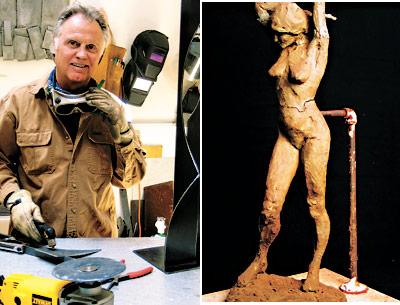Dennis Leri: Perpetual Student

Dennis Leri has been showing his work — mixed-media wall pieces blending metal and canvas and paint, and large works of abstract sculpture — for more than 20 years on the East End.
He started by studying figurative sculpture at the Art Students League and the Sculpture Center, but his love of art began before that — at home.
“I lived in a house full of art,” Mr. Leri said of his upbringing in Brooklyn. “It was a typical Italian-American family with several generations living together. My uncle John Nappi was an artist and had his studio in the house.”
Mr. Leri served in Vietnam, and when he came back his sister, the artist Lorraine Danzo, made a suggestion to the foundering veteran. “She said, ‘Dennis, you’re not right in the head. Do your art, it’s the only thing that will bring you peace,’ ” Mr. Leri recalled the other day.
He began with figurative work. “I was an academic,” he said. “A perpetual student. I still am.”
After a move to Springs in the mid-1980s, Mr. Leri was “tickled to be invited” to a group show at Ashawagh Hall in the early 1990s. “It’s an awfully good place to get a start in art,” he said. “You meet a hell of a lot of people.”
Today, Mr. Leri serves as the chairman of Ashawagh Hall’s art committee, a position he obviously enjoys. “There were 600 artists shown this year,” he said. “And the year’s not over.” He also buys some of the pieces, and over the years his house has become “filled with stuff from Ashawagh Hall,” he said.
It was shortly after his first show that he “started to abstract. Then I got into mixed media and work with metals.” Presenting himself at the door of James DeMartis, a Springs blacksmith and artist, he learned to weld, and from there found his calling.
Mr. Leri is known for large, geometric, abstract pieces, many of which are now in public spaces and private collections. He also makes wall sculptures, squares of metal in a frame, with various textures to form three-dimensional works of art. He was awarded “best mixed media” at Guild Hall’s 71st annual artist members exhibit.
The artist has kept a hand in academia, this time as a teacher. He has led classes at his studio and now is leading adult workshops at the Golden Eagle art store in East Hampton, specializing in mixed media and figure sculpture.
“It’s been an interesting journey,” he said. He had been surprised when he received a call from the store’s owner, Nancy Rowan, asking, “Do you know how to teach figurative?” But the return to his roots has provided an interesting twist in his teaching and his artwork.
“We haven’t had a life model,” he said. One is coming in the spring. “So when I’ve been teaching, I’ve had to recommend anatomy books and break the human body down into different geometric shapes — which is what I do,” he explained.
He has also seen how the figurative influence has affected his art. “Since I’ve been teaching, I’ve seen the difference in my geometric forms. You get influenced. There is a gentle sway and curve in my latest work that mimics the body.”
Lately, Mr. Leri has been concentrating on smaller sculpture. The desk in his studio is covered with maquettes of paper pieces, abstract origami ready to be turned into larger works of brushed steel and other metals. Four pieces of work, each the size of a 3-year-old, are wrapped and ready to ship.
Mr. Leri commented on the recent economic downturn and its effect on his art: “You have to adapt,” he said. His uncle, the artist, told him, “You’re a fine artist, but an artist needs to eat,” Mr. Leri recalled with a smile. “Make sure to get a trade, so you always have a way to make a living, and do your art.”
“If you don’t have a living, you’ll make whatever sells,” Mr. Leri said. “And then, you’re lost.”
